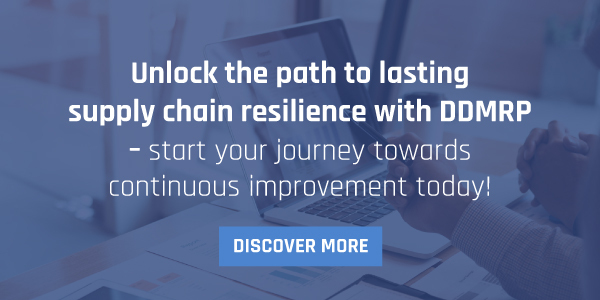
The Role of Technology in DDMRP Optimization
November 24, 2023
Advanced DDMRP Planning: Strategies for Efficient Inventory Management
December 11, 2023Demand Driven Material Requirement Planning (DDMRP) has emerged as a transformative approach to supply chain management, providing organisations with the ability to synchronise their processes with actual demand. As companies increasingly adopt DDMRP, it becomes imperative to not only implement it effectively but also to continuously audit and evaluate its performance. This article explores the importance of auditing DDMRP implementations and outlines key aspects to consider in the evaluation process.
The Essence of DDMRP
The essence of Demand Driven Material Requirement Planning (DDMRP) lies in its departure from traditional forecasting methods. Unlike conventional approaches that rely heavily on predictive models, DDMRP is a demand driven strategy. It centres around replenishing inventory based on real-time demand signals, acknowledging the inherent uncertainties in the market. This fundamental shift allows organisations to respond dynamically to demand fluctuations, adapting their inventory levels to match actual needs.
The core strength of DDMRP lies in its ability to minimise excess inventory. By synchronising inventory levels with current demand, organisations can avoid overstocking and the associated carrying costs. This not only leads to cost savings but also streamlines operational efficiency. Furthermore, DDMRP addresses the challenge of reducing lead times in the supply chain. The approach recognizes that responsiveness to market demands requires a reduction in the time it takes for products to move from order to delivery.
Enhancing overall supply chain responsiveness is a key outcome of effective DDMRP implementation. The strategy aligns production and distribution with actual demand, creating a more agile and adaptable supply chain. However, the success of DDMRP is not a one-time achievement; it hinges on continuous monitoring and evaluation. In a rapidly evolving business landscape, organisations must regularly assess the effectiveness of their DDMRP systems. This ongoing evaluation ensures that the dynamic nature of market demands is met with equally flexible and responsive supply chain strategies, thereby securing the sustained success of DDMRP implementations.
Importance of Auditing DDMRP
1. Adaptability to Changing Demand Patterns
Auditing Demand Driven Material Requirement Planning (DDMRP) is integral to evaluating its adaptability to the dynamic shifts in demand patterns. In the contemporary business landscape, influenced by ever-changing consumer behaviours, evolving market trends, and external factors, demand can be unpredictable. Regular audits serve as a crucial mechanism to scrutinise the responsiveness of the DDMRP system to these fluctuations. The process involves a thorough analysis of how well the system adapts to changes, ensuring its effectiveness in meeting shifting demand.
Identifying areas that require adjustments is a central goal of DDMRP auditing, ensuring that the organisation maintains agility and proficiency in responding to evolving market demands. This adaptability may involve updating parameters within the DDMRP system or recalibrating forecasting models to align with current demand patterns. The auditing process not only highlights potential areas for improvement but also enables organisations to proactively fine-tune their strategies. Ultimately, the adaptability of DDMRP to changing demand patterns, emphasised through regular audits, positions businesses to navigate uncertainties effectively and maintain a competitive edge in the face of dynamic market conditions.
2. Optimising Inventory Levels
Demand Driven Material Requirement Planning (DDMRP) centres its objective on the maintenance of optimal inventory levels through dynamic adjustments based on actual demand signals. Auditing plays a pivotal role in ensuring the alignment of inventory levels with prevailing demand patterns. Continuous assessments through regular audits serve as a strategic tool to evaluate and fine-tune inventory management strategies.
By scrutinising inventory levels, organisations can proactively avoid excess stock, reducing carrying costs and preventing stockouts. This not only optimises operational efficiency but also enhances overall supply chain performance. The dynamic nature of business conditions and evolving customer preferences underscores the importance of regular audits. These assessments serve as a proactive measure, allowing organisations to adapt and realign their inventory strategies to remain in sync with both organisational goals and the ever-changing dynamics of the market.
In essence, optimising inventory levels through DDMRP and regular auditing ensures that organisations maintain a lean and responsive supply chain. This adaptability positions businesses to navigate fluctuations in demand effectively, reducing unnecessary holding costs and enhancing overall operational efficiency.

3. Reducing Lead Times
Reducing lead times is integral to achieving efficient supply chain management, enhancing overall responsiveness to market demands. Auditing Demand Driven Material Requirement Planning (DDMRP) implementations becomes a strategic imperative in achieving this goal. Through comprehensive analysis and scrutiny of lead times across various stages of the supply chain, organisations can identify bottlenecks and areas ripe for improvement.
By delving into the intricacies of the supply chain through audits, companies can streamline processes, resulting in a notable reduction in lead times. This not only empowers the organisation to respond promptly to customer demands but also fosters improved coordination with suppliers. The insights gained from these audits serve as a valuable resource for implementing strategic changes that enhance overall operational efficiency.
Ultimately, the reduction of lead times through the auditing of DDMRP implementations contributes significantly to the creation of a more responsive and agile supply chain. Businesses that prioritise this aspect of supply chain management are better positioned to adapt swiftly to market dynamics, gaining a competitive edge through enhanced customer satisfaction and more efficient collaboration with suppliers.
Key Aspects of Auditing DDMRP
1. Assessing Inventory Levels
Auditing inventory levels is a critical aspect of evaluating the effectiveness of Demand Driven Material Requirement Planning (DDMRP). This process involves a thorough examination of actual inventory levels in comparison to the expected levels derived from demand signals. Deviations identified during the audit serve as vital indicators, highlighting potential disparities between projected and actual demand. These variations signal the need for recalibrating DDMRP parameters, ensuring a more precise alignment with current demand patterns. By shining a spotlight on inventory levels, organisations can proactively fine-tune their strategies, mitigating the risks associated with excess inventory or stockouts. This meticulous approach enhances the overall efficiency of supply chains, promoting a more responsive and adaptive approach to inventory management.
2. Evaluating Lead Times
Lead times are pivotal in determining the responsiveness of the supply chain, making their evaluation a key component of DDMRP auditing. Auditing lead times involves tracking the duration it takes for products to move from the initial order to delivery. This process provides valuable insights into the efficiency of the supply chain, allowing organisations to identify and address bottlenecks. Through the audit, processes can be streamlined, resulting in a significant improvement in overall lead times. A reduced lead time not only heightens customer satisfaction by enabling quicker responses to demand but also contributes to increased operational efficiency throughout the supply chain, positioning the organisation for enhanced competitiveness.

3. Validating Demand Forecasts
Understanding the level of accuracy of demand forecasts is paramount for the success of DDMRP, and auditing demand forecasts plays a crucial role in maintaining this accuracy. This audit involves a comprehensive comparison of predicted demand against actual demand over a specified period. Discovering significant variances during the audit triggers a reassessment of forecasting models and parameters. This iterative process ensures that the organisation’s forecasting capabilities remain aligned with the dynamic nature of market demands, fostering enhanced overall accuracy and reliability in predicting and meeting customer needs.
4. Monitoring Supplier Performance
Recognizing that a DDMRP system is only as robust as its weakest link, auditing supplier performance is imperative. This involves a comprehensive evaluation of factors such as delivery reliability, product quality, and responsiveness. By identifying and addressing any issues with suppliers, organisations contribute to the resilience and effectiveness of their DDMRP implementation. A seamless and reliable supply chain relies on strong collaboration with suppliers, making supplier performance a critical aspect of DDMRP auditing. This process ensures that the entire supply chain, including external partners, is aligned and capable of meeting the demands of a dynamic marketplace.
5. Utilising Key Performance Indicators (KPIs)
Establishing and closely monitoring Key Performance Indicators (KPIs) specific to Demand Driven Material Requirement Planning (DDMRP) is a critical component of a comprehensive audit strategy. These KPIs, encompassing metrics such as inventory turns, on-time delivery, and order fulfilment rates, offer a quantitative measure of DDMRP performance. Regularly tracking these indicators provides a data-driven approach, offering valuable insights into the effectiveness of DDMRP implementation.
KPIs serve as a navigational guide, directing attention to specific areas within the supply chain that require improvement or adjustment. They act as a performance compass, helping organisations stay on course towards their goals. The continuous tracking of these metrics not only ensures ongoing effectiveness but also fosters a culture of continuous improvement within the organisation’s DDMRP implementation.
This commitment to monitoring and optimising KPIs promotes adaptability and resilience in the face of evolving market dynamics. By leveraging data-driven insights, organisations can proactively respond to challenges, fine-tune strategies, and enhance overall performance. Ultimately, the systematic use of KPIs in DDMRP audits not only measures success but also propels organisations toward a culture of perpetual enhancement, positioning them to thrive in an ever-changing business landscape.

Continuous Improvement through Performance Evaluation
Continuous improvement is at the core of DDMRP philosophy, and performance evaluation is the engine that drives it. Organisations should view DDMRP implementation as an iterative process, with each audit leading to refinements and enhancements. Here are some strategies for ongoing performance evaluation:
-
Feedback Loops and Collaboration
Establishing feedback loops within an organisation is a cornerstone of successful DDMRP implementation. These loops create channels for communication and collaboration among different departments involved in the supply chain. Regular meetings and discussions provide a platform for cross-functional teams to share insights, challenges, and best practices. This collaborative approach not only breaks down silos but also fosters a culture of continuous improvement. Through shared experiences and perspectives, teams can collectively address issues, identify opportunities, and fine-tune the DDMRP system to better meet the organisation’s evolving needs. Feedback loops, when institutionalised, become a powerful mechanism for promoting agility and adaptability within the supply chain.
-
Training and Skill Development
Investing in the training and skill development of personnel engaged in DDMRP implementation is a critical component of ensuring sustained success. Regular training sessions keep the workforce abreast of the latest developments in demand-driven methodologies and technologies. This continuous learning approach ensures that employees remain adept at utilising the DDMRP system to its full potential. Well-trained personnel are not only more efficient in their roles but also contribute to the overall adaptability of the organisation. As the business landscape evolves, a skilled workforce becomes instrumental in navigating challenges, optimising processes, and extracting maximum value from the DDMRP system.

-
Benchmarking Against Industry Standards
Benchmarking DDMRP performance against industry standards and best practices provides a valuable external perspective. By comparing its practices to those of other organisations, a company can gain insights into areas of improvement and innovation. Understanding how other entities have successfully overcome similar challenges inspires creative problem-solving and drives continuous improvements in DDMRP implementation. This benchmarking process helps organisations stay competitive and ensures that their DDMRP strategies align with the industry’s evolving norms and expectations.
-
Technology Integration and Upgrades
Staying at the forefront of technological advancements is crucial for the ongoing success of DDMRP. Embracing and integrating the latest technologies into the supply chain is essential for efficiency and competitiveness. Regular assessments of the compatibility of existing systems with emerging technologies facilitate informed decisions about upgrades. This proactive approach ensures that the organisation can leverage the latest tools to enhance DDMRP performance. Whether it’s implementing advanced analytics, artificial intelligence, or other cutting-edge technologies, staying technologically current is integral to optimising the capabilities of the DDMRP system and maintaining a competitive edge in the dynamic landscape of supply chain management.
Conclusion
In conclusion, auditing and performance evaluation are integral components of successful DDMRP implementations. The dynamic nature of business environments necessitates continuous monitoring and adjustment to ensure that the benefits of DDMRP are sustained over time. By focusing on key aspects such as inventory levels, lead times, demand forecasts, and supplier performance, organisations can optimise their supply chains and remain agile in the face of changing market dynamics. Adopting a mindset of continuous improvement through ongoing evaluation will position businesses to thrive in an ever-evolving global marketplace.
Discover how to conduct audits and evaluate the performance of your DDMRP implementation to ensure it’s operating at its best!





